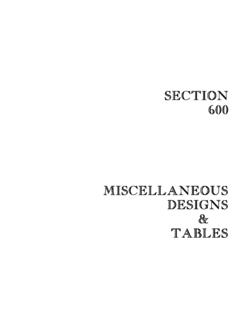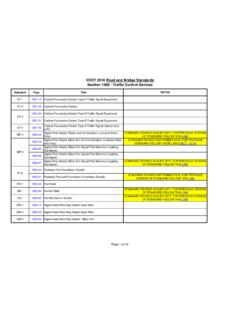Transcription of Access Management Design Standards for Entrances and ...
1 APPENDIX F. Access Management Design Standards for Entrances and Intersections PREFACE. The Access Management regulations and Standards do not apply in cities, towns of more than 3,500 and in counties (Henrico and Arlington) that maintain their secondary roads (they do apply on primary routes in these two counties). Such localities, though, may choose to apply them to roads they maintain. The 2007 General Assembly unanimously approved legislation (Chapter 863) proposed by the Governor to direct VDOT's commissioner to develop, solicit public input on, and publish Access Management regulations and Standards by December 31, 2007 to become effective July 1, 2008.
2 The legislative goals for Access Management are to: Reduce traffic congestion, Enhance public safety by decreasing traffic crash rates, Support economic development by promoting the efficient movement of people and goods, Reduce the need for new highways and road widening by maximizing the performance of the existing state highways, and Preserve the public investment in new highways. To assure that a wide variety of viewpoints were considered, multiple techniques were used to gain public input on the draft regulations and Standards .
3 The commissioner approved and published the regulations and Standards in December 2007. The Access Management * regulations and Standards were implemented in phases. The first phase applied to VDOT highways classified as principal arterials taking effect July 1, 2008 and second phase applies to minor arterials, collectors and local streets which became effective October 14, 2009. For regulatory efficiency and streamlining on December 5, 2013 the two sets of Access Management regulations were consolidated into one: the Access Management Regulations 24 VAC30-73, applying to all highways.
4 This Appendix, therefore, contains the Standards for the Design of intersections, turning lanes, and Entrances and for the spacing of Entrances , intersections, traffic signals, median crossovers that apply to all state highways: principal arterials, minor arterials, collectors, and local streets. If a Design standard cannot be met a Design exception or waiver is required. If a spacing standard cannot be met, a spacing exception is required. For more information, see Exceptions to the Spacing Standards and Exceptions/Waivers to the Design Standards in Section 2.
5 NOTE: 1. Maps of state highways by functional classification and information on the Access Management program are on the VDOT web site. 2. The Standards do not apply to proposed VDOT minor arterials, collectors and local streets if the construction Design plans were presented at a VDOT public hearing prior to October 14, 2009 or principal arterials prior to July 1, 2008. *. Rev. 1/14. Table of Contents DEFINITIONS .. F-1 SECTION 1- INTRODUCTION Access Management Concepts .. F-7 Functional F-8 Functional Classification of State Highways.
6 F-8 Access Contol Policy (Full and Partial) .. F-10 SECTION 2 INTERSECTION Design ; SPACING Standards Intersection Design Objectives .. F-14 Intersection Design Principles .. F-15 Minimum Angle of Intersections .. F-21 Signalized Intersection Spacing .. F-24 General Intersection and entrance Spacing Criteria .. F-25 Minimum Spacing Standards for Commercial Entrances , Intersections, and Median Crossovers .. F-26 Spacing St'ds. for Commercial Entrances /Intersections Near Interchange Ramps .. F-30 Exceptions/Waivers to the Spacing Standards / Access Management Requirements.
7 F-32 Exceptions/Waivers to the Design Standards .. F-32 Traffic Signals and Median Crossovers .. F-33 Median Crossover Location Approval Process: .. F-34 Signalized and Unsignalized Intersection Design (Corner Island Designs) .. F-37 Intersection Sight Distance .. F-40 Stopping Sight Distance .. F-42 Median Crossovers .. F-45 Median Crossover Grades .. F-45 Intersecting Cross Road F-48 Innovative Intersection and Interchange Policies .. F-48 Roundabout Policy .. F-48 Innovative Intersection and Interchange Policy.
8 F-49 Accommodating Pedestrians and Bicyclists .. F-51 SECTION 3 TURNING LANES Turn Lane Criteria for Single and Dual Lanes .. F-55 Warrants for Left Turn Storage Lanes on Four-Lane Highways .. F-57 Warrants for Left Turn Storage Lanes on Two-Lane Highways .. F-58 Taper Lengths (L) - Lane/Pavement Transitions and Merging Tapers .. F-61 Double (Dual) Left-Turn Lanes .. F-72 Continuous Two-Way Left-Turn Lanes (TWLTL's) .. F-72 Medians .. F-75 Illustration of Directional Median Crossover for Left Turns and U-Turns.
9 F-77 Right Turn Lanes .. F-78 Acceleration/Deceleration Lanes .. F-82 SECTION 4 entrance Design . entrance Design Principles .. F-88. entrance Definitions .. F-88. Private and Low Volume Commercial Entrances .. F-89. Commercial Entrances .. F-91. Commercial entrance Sight Distance .. F-95. Limits of Maintenance Responsibility for Private and Commercial F-96. Commercial entrance Separation from an Intersection .. F-96. Commercial entrance Channelization Island Options .. F-98. Commercial entrance Spacing.
10 F-99. Corner Clearance on a Minor Side F-99. entrance Connections on Opposite Sides of a Roadway .. F-101. entrance Consolidation (Shared Use Entrances ).. F-102. Interparcel Vehicular Connections .. F-102. Frontage F-104. Entrances Affected by Highway Construction Projects .. F-105. Commercial entrance Design to Serve A Private Subdivision Road/Street .. F-107. Commercial entrance Designs along Highways with Shoulders .. F-108. Commercial entrance Designs along Highways with Curb and Gutter .. F-109.



